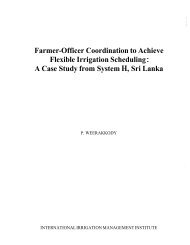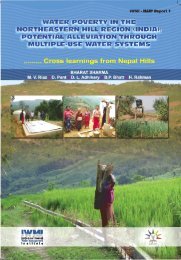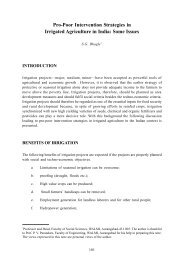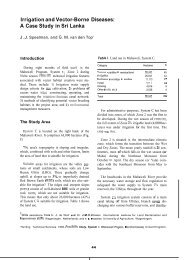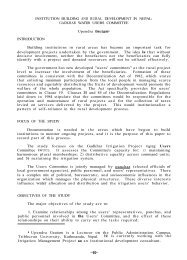The Impact of Small Scale Irrigation on Household Food Security ...
The Impact of Small Scale Irrigation on Household Food Security ...
The Impact of Small Scale Irrigation on Household Food Security ...
Create successful ePaper yourself
Turn your PDF publications into a flip-book with our unique Google optimized e-Paper software.
Chamber (1994) based <strong>on</strong> some empiricalstudies c<strong>on</strong>firms that reliable and adequateirrigati<strong>on</strong> increases employment, i.e., Landlesslaborers as well as small and marginal farmershave more work <strong>on</strong> more days<str<strong>on</strong>g>of</str<strong>on</strong>g> the year, which ultimately c<strong>on</strong>tributes to foodsecurity. A study c<strong>on</strong>ducted in 10 Indian villagesin different agro-climatic regi<strong>on</strong>s shows thatincreasing irrigati<strong>on</strong> by 40 percent was equallyeffective in reducing poverty (reducing foodinsecurity) as providing a pair <str<strong>on</strong>g>of</str<strong>on</strong>g> bullocks,increasing educati<strong>on</strong>al level and increasing wagerates (Singh et al., 1996). Kumar (2003) alsostated that irrigati<strong>on</strong> has significantlyc<strong>on</strong>tributed to boosting India's food producti<strong>on</strong>and creating grain surpluses used as droughtbuffer. A study by Hussain et al. (2004)c<strong>on</strong>firms that access to reliable irrigati<strong>on</strong> watercan enable farmers to adopt new technologiesand intensify cultivati<strong>on</strong>, leading to increasedproductivity, overall higher producti<strong>on</strong>, andgreater returns from farming. This in turn opensup new employment opportunities; both <strong>on</strong> farmand <str<strong>on</strong>g>of</str<strong>on</strong>g>f-farm, and can improve incomes,livelihood, and the quality <str<strong>on</strong>g>of</str<strong>on</strong>g> life in rural areas.<str<strong>on</strong>g>The</str<strong>on</strong>g> same study identified five key dimensi<strong>on</strong>s<str<strong>on</strong>g>of</str<strong>on</strong>g> how access to good irrigati<strong>on</strong> waterc<strong>on</strong>tributes to socioec<strong>on</strong>omic uplift <str<strong>on</strong>g>of</str<strong>on</strong>g> ruralcommunities. <str<strong>on</strong>g>The</str<strong>on</strong>g>se are producti<strong>on</strong>, income andc<strong>on</strong>sumpti<strong>on</strong>, employment, food security, andother social impacts c<strong>on</strong>tributing to overallimproved welfare.According to a study carried out <strong>on</strong> fiveirrigati<strong>on</strong> schemes in Zimbabwe, the schemeswere found to act as sources <str<strong>on</strong>g>of</str<strong>on</strong>g> food security forthe participants and the surrounding communitythrough increased productivity, stableproducti<strong>on</strong> and incomes (Mudima, 1998). <str<strong>on</strong>g>The</str<strong>on</strong>g>same study reported that farmers participating inirrigati<strong>on</strong> schemes never run out <str<strong>on</strong>g>of</str<strong>on</strong>g> food unliketheir counterparts that depend <strong>on</strong> rain-fedagriculture.Ngigi (2002) disclosed that in Kenya for the twodecades agricultural producti<strong>on</strong> has not beenable to keep pace with the increasing populati<strong>on</strong>.To address this challenge the biggest potentialfor increasing agricultural producti<strong>on</strong> lies in thedevelopment <str<strong>on</strong>g>of</str<strong>on</strong>g> irrigati<strong>on</strong>. According to thesame study, irrigati<strong>on</strong> can assist in agriculturaldiversificati<strong>on</strong>, enhance food self sufficiency,increase rural incomes, generate foreignexchange and provide employment opportunitywhen and where water is a c<strong>on</strong>straint. Nigigic<strong>on</strong>cluded that the major c<strong>on</strong>tributi<strong>on</strong>s <str<strong>on</strong>g>of</str<strong>on</strong>g>irrigati<strong>on</strong> to the nati<strong>on</strong>al ec<strong>on</strong>omy are foodsecurity, employment creati<strong>on</strong>, and improvedforeign exchange earning.A study by IFAD (2005) states that in Ethiopia,the c<strong>on</strong>structi<strong>on</strong> <str<strong>on</strong>g>of</str<strong>on</strong>g> small-scale irrigati<strong>on</strong>schemes has resulted in increased producti<strong>on</strong>,income and diet diversificati<strong>on</strong> in the Oromiaand Southern Nati<strong>on</strong> and Nati<strong>on</strong>alities People(SNNP) regi<strong>on</strong>s. According to this study, thecash generated from selling vegetables and otherproduce is comm<strong>on</strong>ly used to buy food to coverthe household food demand during the fooddeficit m<strong>on</strong>ths. <str<strong>on</strong>g>The</str<strong>on</strong>g> same study further addedthat during an interview c<strong>on</strong>ducted with somefarmers, it was disclosed that the hungry m<strong>on</strong>thsreduced from 6 to 2 m<strong>on</strong>ths (July and August)because <str<strong>on</strong>g>of</str<strong>on</strong>g> the use <str<strong>on</strong>g>of</str<strong>on</strong>g> small scale irrigati<strong>on</strong>.Moreover, the increase in diversity <str<strong>on</strong>g>of</str<strong>on</strong>g> cropsacross the schemes and the shift from cereallivestocksystem to cereal-vegetable-livestocksystem is starting to improve the diversity <str<strong>on</strong>g>of</str<strong>on</strong>g>household nutriti<strong>on</strong> through making vegetablespart <str<strong>on</strong>g>of</str<strong>on</strong>g> the daily diet. A study c<strong>on</strong>ducted byWoldeab (2003) also identified that in Tigrayregi<strong>on</strong> irrigated agriculture has benefited somehouseholds by providing an opportunity toincrease agricultural producti<strong>on</strong> through doublecropping and by taking advantage <str<strong>on</strong>g>of</str<strong>on</strong>g> moderntechnologies and high yielding crops that calledfor intensive farming.However, these studies were descriptive thananalytical in that they did not formally accountfor/ isolate the possible c<strong>on</strong>tributi<strong>on</strong> <str<strong>on</strong>g>of</str<strong>on</strong>g> otherc<strong>on</strong>founding variables such hashousehold/village characteristics, and otherpolicies and interventi<strong>on</strong>s that might have aswell c<strong>on</strong>tributed to the food security statusdifferences between irrigators and n<strong>on</strong>-irrigators.Moreover, the empirical works in this area arevery scant in Ethiopia in particular and in Africain general. Thus, the study aims to c<strong>on</strong>tribute tothe small scale irrigati<strong>on</strong>-food security literatureand to provide policy c<strong>on</strong>clusi<strong>on</strong>s and180



